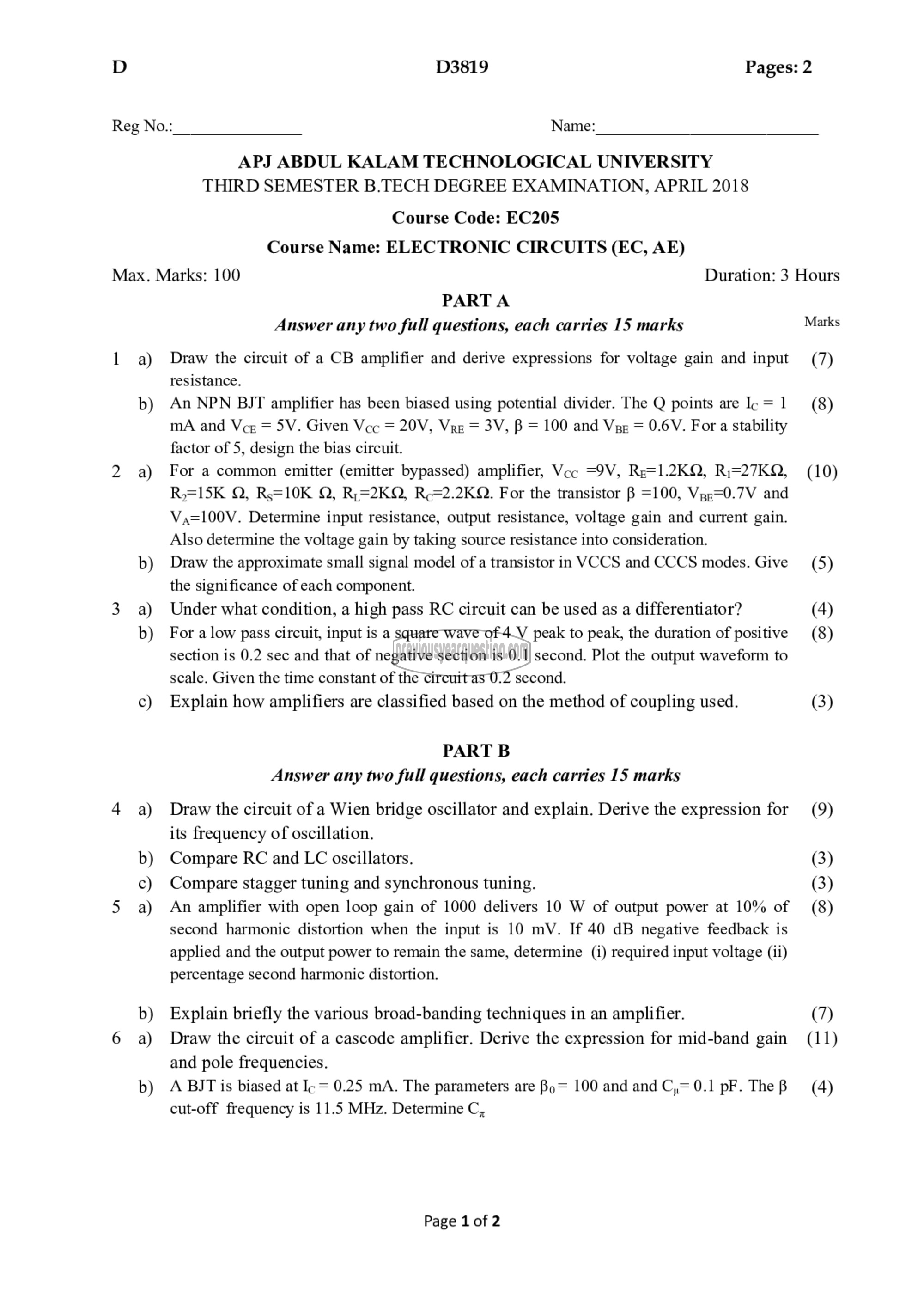APJ ABDUL KALAM TECHNOLOGICAL UNIVERSITY Previous Years Question Paper & Answer
Semester : SEMESTER 3
Subject : Electronic Circuits
Year : 2018
Term : APRIL
Scheme : 2015 Full Time
Course Code : EC 205
Page:1
D D3819 Pages: 2
Reg No.: Name:
APJ ABDUL KALAM TECHNOLOGICAL UNIVERSITY
THIRD SEMESTER B.TECH DEGREE EXAMINATION, APRIL 2018
Course Code: EC205
Course Name: ELECTRONIC CIRCUITS (EC, AE)
Max. Marks: 100 Duration: 3 Hours
PART A
Answer any two full questions, each carries 15 marks Marks
1 a) Draw the circuit of a CB amplifier and derive expressions for voltage gain and input (7)
resistance.
b) An NPN BJT amplifier has been biased using potential divider. The Q points صد 1751 (8)
mA and ४८ = 5V. Given م۷ = 20۷, Var = 3۷, B = 100 and جح۷ = 0.6V. For a stability
factor of 5, design the bias circuit.
2 a) For a common emitter (emitter bypassed) amplifier, Vec =9V, Re=1.2KQ, Ri=27KQ, (10)
1२,5८1 514 ६2, R=10K ६2, 11-21, R-=2.2KQ. For the transistor B =100, Vgp=0.7V and
V,a=100V. Determine input resistance, output resistance, voltage gain and current gain.
Also determine the voltage gain by taking source resistance into consideration.
b) Draw the approximate small signal model of a transistor in VCCS and CCCS modes. Give (5)
the significance of each component.
3 a) Under what condition, ೩ high pass RC circuit can be used as a differentiator? (4)
b) For a low pass circuit, input is a square wave of 4 V peak to peak, the duration of positive (8)
section is 0.2 sec and that of negative section is 0.1 second. Plot the output waveform to
scale. Given the time constant of the circuit as 0.2 second.
c) Explain how amplifiers are classified based on the method of coupling used. (3)
PART B
Answer any two full questions, each carries 15 marks
4 a) Draw the circuit of a Wien bridge oscillator and explain. Derive the expression for (9)
its frequency of oscillation.
b) Compare RC and LC oscillators. (3)
c) Compare stagger tuning and synchronous tuning. (3)
5 a) An amplifier with open loop gain of 1000 delivers 10 W of output power at 10% of (8)
second harmonic distortion when the input is 10 mV. If 40 dB negative feedback is
applied and the output power to remain the same, determine (i) required input voltage (ii)
percentage second harmonic distortion.
b) Explain briefly the various broad-banding techniques in an amplifier. (7)
6 a) Draw the circuit of a cascode amplifier. Derive the expression for mid-band gain (11)
and pole frequencies.
b) A BJT is biased at 10 = 0.25 mA. The parameters are 305 100 and and (= 0.1 pF. The 8 (4)
cut-off frequency is 11.5 MHz. Determine C,
Page 1 of 2
